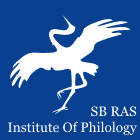 |
|
||||||||||||
|
Institute of Philology of
the Siberian Branch of Russian Academy of Sciences |
|
||||||||||||
|
|||||||||||||
| Sibirskii Filologicheskii Zhurnal (Siberian Journal of Philology) | |
|
Article
Authors: V. V. Gavrilov Surgut State Pedagogical University, Surgut, Russian Federation In the section Study of literature
Abstract: The paper considers the Orphic motifs in V. Nabokov’s short story “Spring in Fialta.” The story under consideration is regarded to be interesting from the point of view of mythological allusions, and first of all, concerning the myth of Orpheus and Eurydice. The idea is that the char-acters of the story find themselves in a special world, which, in fact, is otherworldly and afterlife. The main character descends to hell, like Orpheus. The living person makes a catabasis, comes to the almost dead person, turning into a shadow to bring her out of hell. They need time to find each other and to get to know each other. The hero was supposed to act as a liberator for the main heroine (the author creates all the prerequisites for this), but, due to several reasons, does not perform this function. Thus, we are dealing with a reinterpreted mythological plot. The myth of Orpheus and Eurydice finds an unexpected interpretation in the story. The paper puts forward the thesis of a twofold world since the real world (of living people) and the otherworldly world (of the dead) are brought together in the story. A number of argu-ments are given. The main character Nina shows some signs of a being from the afterlife: she does not immediately recognize the hero (blindness inherent in the dead, loss of memory). Also, of importance is the symbol, a rusty key never used by a hero, that proves that the hero goes down to hell in the hope of freeing the heroine. The circus occupies a particular place in the story: the author and the heroes of the story try to overcome through carnival the fear of death, to forget about the verdict of inexorable fate, the hopelessness of existence in the world of shadows. Keywords: V. Nabokov, “Spring in Fialta”, orphic motifs, Orpheus and Eurydice, myth, ambivalence, catabasis Bibliography: Antoshina E. V. “Drugiye miry” v prozaicheskikh syuzhetakh V. V. Nabokova i G. Dzh. Uellsa [“Other worlds” in prose stories by V. V. Nabokov and G. J. Wales]. Siberian Journal of Philology. 2015, no. 3, pp. 161–168. Asoyan A. A. Semiotika mifa ob Orfee i Evridike [Semiotics of the myth of Orpheus and Eurydice]. St. Petersburg, Aleteyya, 2015, 136 p. Bakhtin M. M. Rabochie zapisi 60-h – nachala 70-h godov [Working records of the 60s – early 70s]. In: Bakhtin M. M. Sobr. soch. v 7 t. [Collected works. in 7 vols]. Moscow, LRC Publishing House, Russkie slovari, 2002, vol. 6, pp. 371–439. Belyaeva I. S. Pobeda avtora nad rasskazchikom: “Otchayanie” Vladimira Nabokova kak “naskvoz’ parodiynyy roman” [The author’s victory over the narrator: “Despair” by Vladimir Nabokov as “a completely parodic novel”]. The New Philological Bulletin. 2012, no. 1 (20), pp. 36–45. Boyd B. Vladimir Nabokov. Russkie gody. Biografiya [Vladimir Nabokov. Russian years. Biography]. Moscow, Simpozium, 2001, pp. 496–497. Mify narodov mira. Entsiklopediya: V 2 t. [Myths of the world. Encyclopedia: in 2 vols]. Moscow, Ros. Entsikl., 1994, vol. 1, 671 p. Nabokov V. Krug: Poeticheskie proizvedeniya; Rasskazy [Circle: Poetry, short stories]. Leningrad, Khudozh. lit., 1990, 544 p. Propp V. Ya. Istoricheskie korni volshebnoy skazki [Historical roots of a fairy tale]. St. Petersburg, SPbSU Publ., 1996, 365 p. Tammi P. Problems of Nabokov’s Poetics: A Narratological Analysis. Helsinki, 1985, 303 p. Zenkin S. Ambivalentnost’ sakral’nogo i slovesnaya kul’tura (Bakhtin i Dyurkgeym) [Ambivalence of sacred and verbal culture (Bakhtin and Durkheim)]. New Literary Observer. 2015, no. 2. URL: https://magazines.gorky.media/nlo/2015/2/ambivalentnost-sakralnogo-i-slovesnaya-kultura.html (accessed: 31.05.2020). |
 |
Institute of Philology Nikolaeva st., 8, Novosibirsk, 630090, Russian Federation +7-383-330-15-18, ifl@philology.nsc.ru |
© Institute of Philology |


